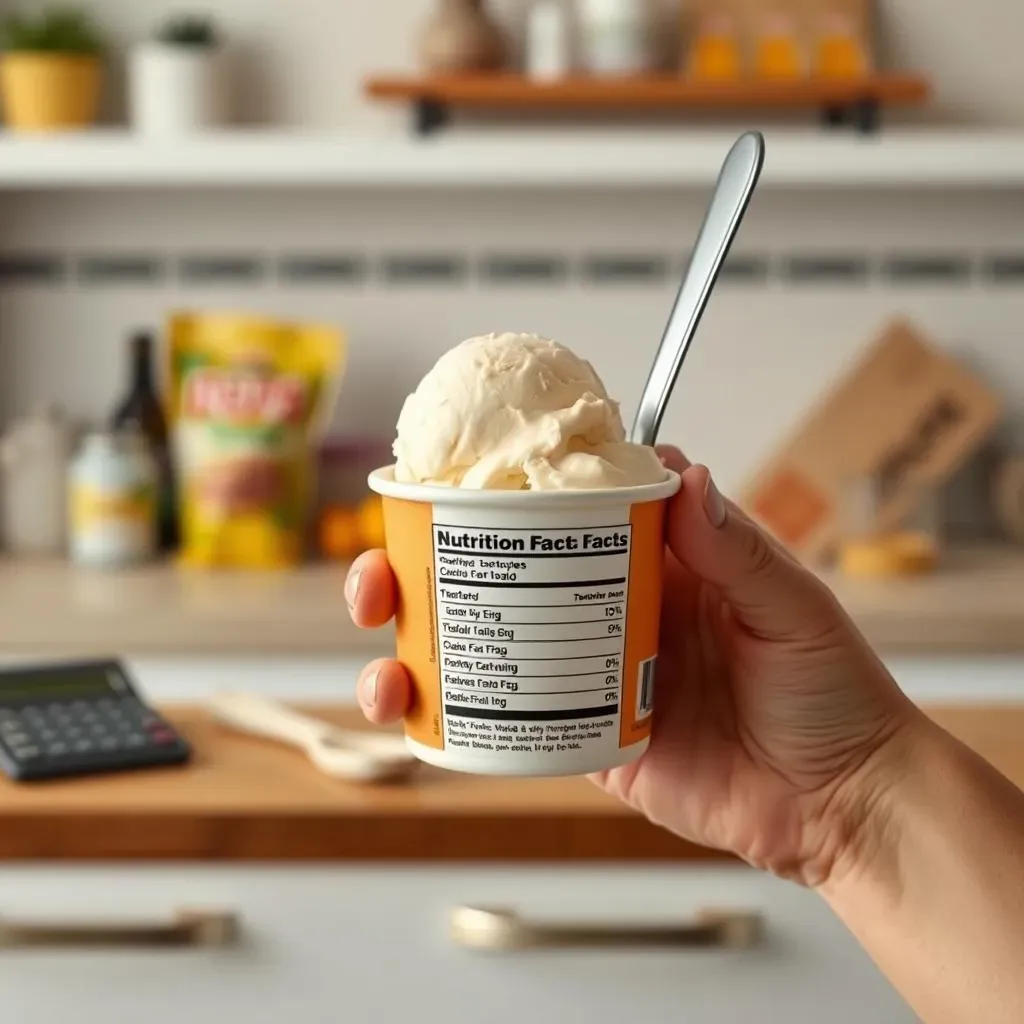Table of Contents
Ever found yourself staring into the freezer, a spoon in hand, wondering about the calories in low fat ice cream? You're not alone. Ice cream, that creamy, dreamy dessert, often gets a bad rap, and for good reason. It's typically loaded with sugar, fat, and calories, but what about those "healthier" low fat options? Are they truly a guilt-free treat, or just clever marketing? This article will guide you through the chilly world of ice cream, exploring its nutritional downsides, and how you can still enjoy a scoop (or two!) without derailing your health goals. We'll navigate the tricky terrain of labels, discuss healthier alternatives, and even peek at making your own delicious, lower-calorie versions. So, grab a spoon, and let's dig in!
The Scoop on Ice Cream's Nutritional Profile

The Scoop on Ice Cream's Nutritional Profile
The Basics: What's in That Scoop?
let's talk ice cream. We all love it, right? But what exactly are we eating? At its core, ice cream is a mix of dairy (usually cream and milk), sugar, and flavorings. The fat from the cream is what gives it that smooth, rich texture we all crave. Sugar adds sweetness, and the flavorings, well, that’s where the magic happens – vanilla, chocolate, strawberry, the list goes on! However, it's not exactly a nutritional powerhouse. Most of the calories come from fat and sugar, with very little in the way of vitamins or minerals. It's more of a treat than a fuel source, if you know what I mean.
And hey, don't get me wrong, I'm not saying you can't enjoy it. But let's be real about what's going into our bodies.
The Calorie Breakdown
When we talk about the calories in low fat ice cream, it's important to understand that "low fat" doesn't always mean "low calorie". Often, to compensate for the lack of fat, manufacturers add more sugar or artificial sweeteners. This can result in a product that has almost the same amount of calories as regular ice cream. A typical serving (about half a cup) of regular ice cream can pack anywhere from 200 to 300 calories, while a "low-fat" version might hover around 150 to 250 calories. And let's not even start on the super-premium stuff; those can easily hit 400+ calories per serving! The key thing to remember is not all calories are created equal. The calories in ice cream are mostly from simple sugars and saturated fats, which aren't exactly great for our health.
Also, who eats just half a cup? I know I don't, and I bet you don't either.
Nutrient | Regular Ice Cream (1/2 cup) | Low Fat Ice Cream (1/2 cup) |
|---|---|---|
Calories | 200-300 | 150-250 |
Fat | 10-20g | 2-7g |
Sugar | 20-30g | 15-25g |
Hidden Ingredients and Additives
Beyond the calories, there's a whole world of hidden ingredients and additives in many ice cream brands. Things like artificial colors, flavors, and thickeners are often used to make the product more appealing, or to extend its shelf life. Some of these additives have been linked to negative health effects, especially if consumed in large quantities. And I'm not just talking about the fake stuff, some of the "natural" flavors aren't as natural as you might think. Always read the label, and pay attention to the ingredient list. The shorter it is, the better, in my opinion. Look out for things like carrageenan, high fructose corn syrup, and artificial colors like Red 40 and Yellow 5. It's like a science experiment in a pint, and not the fun kind.
It's not about banning ice cream, it's about knowing what we're putting into our bodies.
Health Drawbacks of Regular Ice Cream

Health Drawbacks of Regular Ice Cream
The Sugar Rollercoaster
so we’ve talked about what’s in ice cream, but let's get real about what it does to your body. The high sugar content in regular ice cream is a major problem. It causes rapid spikes in your blood sugar, followed by a crash. This rollercoaster ride can leave you feeling tired, irritable, and craving more sugary stuff. It's a vicious cycle! Over time, this can lead to insulin resistance, which increases your risk of type 2 diabetes. And it's not just about diabetes; these sugar spikes also contribute to inflammation throughout your body, which can mess with your overall health. It's like giving your body a sugar punch every time you enjoy a scoop. Not ideal, right?
Honestly, I've felt that sugar crash too many times to count, and it's never fun.
The Fat Factor
Next up, let's talk about the fat. Regular ice cream is loaded with saturated fats, and these aren't the good kind. Saturated fats can raise your LDL cholesterol levels, which is the "bad" kind. High LDL cholesterol increases your risk of heart disease and stroke. It’s like clogging your arteries with butter, but in frozen form. While a little saturated fat isn’t terrible, the amounts in many ice creams are way too high for regular consumption. Combine that with the sugar, and you've got a recipe for some serious health problems down the road. Remember, moderation is key, but it's easy to overdo it with something so tasty.
It's a hard truth to swallow, I know, but better to be informed than blissfully ignorant.
Health Issue | How Ice Cream Contributes |
|---|---|
Type 2 Diabetes | High sugar content leads to insulin resistance |
Heart Disease | High saturated fat increases LDL cholesterol |
Weight Gain | High calories and low nutritional value |
Navigating Ice Cream in a Healthy Diet

Navigating Ice Cream in a Healthy Diet
so we've established that ice cream isn't exactly a health food, but let's be real, sometimes you just need a scoop. The good news is that you don't have to banish it from your life entirely. The key is to enjoy it in moderation and make mindful choices. Think of it like a special treat, not an everyday staple. Instead of reaching for the pint after dinner every night, maybe save it for a weekend indulgence or a special occasion. It's all about balance, right? Treat your body like a temple, but sometimes, that temple can have a little ice cream party. It's about finding a way to fit in the things you enjoy without sacrificing your overall well-being.
I used to think "moderation" was a myth, but trust me, it's possible. And it makes the treats even more enjoyable when you're not overdoing it.
Another good approach is to be aware of your portion sizes. A single serving of ice cream is usually half a cup, but it's easy to scoop out way more than that. Try using a smaller bowl or measuring out your serving size to keep things in check. You could also try pairing your ice cream with something healthy, like a handful of berries or a piece of fruit. This can help balance out the sugar rush and make your treat a bit more nutritious. It’s about being smart and not going overboard, a little bit goes a long way. I've found that if I take the time to sit down and savor a small scoop, it's way more satisfying than inhaling a huge bowl mindlessly. It's all about mindful indulgence.
It's like that saying, "a moment on the lips, a lifetime on the hips," except, you know, with a bit more chill.
Tip | Description |
|---|---|
Moderation | Enjoy ice cream as an occasional treat, not a daily habit |
Portion Control | Stick to recommended serving sizes (usually half a cup) |
Pairing | Combine ice cream with healthier options like fruits |
Smart Choices for Healthier Ice Cream

Smart Choices for Healthier Ice Cream
Decoding the Labels
so you're standing in the frozen aisle, ready to make a smart choice. First things first, let's talk labels. You've got to become a label-reading ninja! Don't just glance at the "low fat" claim and think you're golden. Instead, flip that carton over and look at the nutrition facts. Pay attention to the serving size, which is often smaller than you think. Then, check out the calories, total fat (especially saturated fat), and sugar. Remember, "low fat" doesn't automatically mean "low sugar" or "low calorie." Sometimes, they just replace the fat with more sugar or artificial sweeteners. It's like they're playing a sneaky game with our taste buds, so be vigilant. And don't be afraid to compare different brands and flavors. You might be surprised at the differences. It's all about making informed decisions, not just grabbing the first thing that catches your eye.
I know it sounds like a chore, but trust me, it's worth it. Your body will thank you.
Ingredients Matter
Beyond the numbers, the ingredients list is where the real secrets are revealed. Look for ice creams with shorter, simpler ingredient lists. The fewer the ingredients, the better. Avoid products loaded with artificial colors, flavors, and sweeteners, if you can. Things like carrageenan, high fructose corn syrup, and artificial colors are often red flags. Opt for ice creams that use real ingredients like milk, cream, and natural flavorings. And if you're watching your sugar intake, look for options that use natural sweeteners like stevia or monk fruit, but be mindful that these can still affect your blood sugar. It’s all about choosing real food over processed stuff, even when it comes to a treat like ice cream. It’s a bit like choosing a fresh apple over a candy bar; both might be sweet, but one is clearly better for you.
Honestly, sometimes I feel like I need a translator to understand all the stuff they put in food these days, but a little knowledge goes a long way.
What to Look For | What to Avoid |
|---|---|
Shorter ingredient lists | Long lists with hard-to-pronounce ingredients |
Real ingredients like milk and cream | Artificial colors, flavors, and sweeteners |
Natural sweeteners (stevia, monk fruit) | High fructose corn syrup |
DIY Ice Cream: A Nutritious Alternative

DIY Ice Cream: A Nutritious Alternative
The Magic of Homemade
so you've been navigating the tricky world of store-bought ice cream, and maybe you're feeling a bit overwhelmed. Here's where the real fun begins: making your own! Seriously, DIY ice cream is a game-changer. It's not as hard as you might think, and it gives you total control over the ingredients. You can ditch all the artificial stuff and make something that’s not only delicious but also genuinely good for you. Think of it as a culinary adventure where you get to be the mad scientist, but instead of creating monsters, you’re creating creamy, dreamy goodness. Plus, there's something incredibly satisfying about knowing exactly what you're putting into your body. It’s like a little rebellion against the processed food world, and I'm here for it.
I remember the first time I made my own ice cream; I was amazed at how simple it was and how much better it tasted than anything I'd bought in a store.
Frozen Bananas: Your Secret Weapon
One of the easiest and healthiest ways to make homemade ice cream is by using frozen bananas. Yep, that's right, bananas! When blended, frozen bananas transform into a creamy, ice cream-like consistency. It's like magic! You can add a splash of milk (dairy or non-dairy), a bit of vanilla extract, or some cocoa powder for flavor. The best part? It’s naturally sweet, so you don't need to add a ton of sugar. You can experiment with different add-ins like berries, nuts, or even a pinch of cinnamon. It’s like having a blank canvas for your creativity, but the canvas is edible and delicious. And honestly, it’s so easy that even a kid could make it (and probably will, if you let them!).
I've made banana ice cream so many times, it's become my go-to dessert when I want something sweet but don't want to feel guilty.
Ingredient | Benefit |
|---|---|
Frozen Bananas | Natural sweetness and creamy texture |
Milk (Dairy or Non-Dairy) | Adds creaminess and moisture |
Natural Flavorings (Vanilla, Cocoa) | Enhances taste without artificial additives |
Berries, Nuts, Spices | Adds nutrients and flavor variety |
Beyond Bananas: Expanding Your Options
While frozen bananas are an awesome base, you can also explore other options. Consider using coconut milk for a richer, dairy-free version, or blending avocado for extra creaminess (don’t knock it ‘til you try it!). You can also experiment with using other frozen fruits like berries, mangoes, or peaches. The key is to start with a frozen base and then add your favorite flavors and textures. Think of it as your own personal ice cream laboratory, where you can experiment with different flavors and find your own perfect recipe. It’s all about having fun, being creative, and making something that you can feel good about eating. And remember, the best part is that you’re in control, so you can make it as healthy or as indulgent as you want. It’s your ice cream adventure, so make it epic!
Honestly, once you start making your own ice cream, you’ll never look at store-bought stuff the same way. It’s like discovering a secret level in a video game, and it’s way more fun than you expected.
The Final Scoop on Calories in Low Fat Ice Cream
So, we've journeyed through the frosty landscape of low fat ice cream, and it's clear that while it might be a step down from the full-fat stuff, it's not a free pass to indulge without a second thought. It's still important to be mindful of portion sizes and ingredients. The real secret? Balance. Enjoy a scoop now and then, but don't let it become a daily habit. Focus on a diet rich in whole foods, and when the ice cream craving hits, choose wisely or get creative with homemade options. Ultimately, being informed and making conscious choices is the key to enjoying treats like low fat ice cream without compromising your health. Now, go forth and enjoy your (occasional) scoop responsibly!
